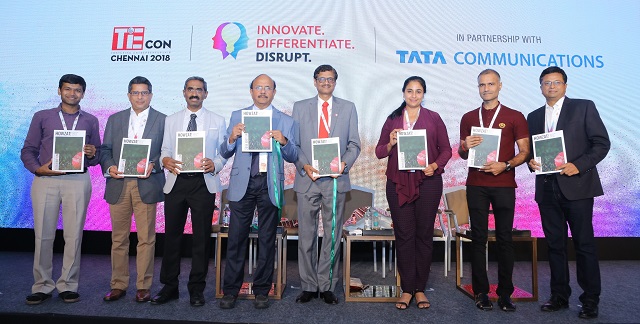Indian Institute of Technology Madras launches the Annual Report on Indian Venture Capital and Private Equity at TiECON 2018
~10th Edition of the Annual Report focused on ‘Success and Impact of Start-ups’~
~Software, Consumer Products & FinTech account for about 63% of companies that receive venture funding: IIT Madras Report~
CHENNAI, 06th October 2018: Three sectors, viz., Software and Internet Services, Consumer Products and Services, and FinTech and Payments account for 63 percent of the companies nationally that received venture funding, according to a study by Indian Institute of Technology Madras.
The Institute released its’ Tenth Annual Report on Indian Venture Capital and Private Equity focusing on ‘The Success and Impact of Start-Ups’ during TiECON Chennai 2018, the Annual Entrepreneurship Conference of TiE Chennai today (06th Oct 2018).
The 2018 report has identified the factors associated with successful ventures in different stages of their lifecycle. This would help the entrepreneurs to better prepare their ventures for success and thus enhance the impact that can be achieved. The report was released at TiECON Chennai 2018, the Annual Entrepreneurship Conference of TiE Chennai today (06th October 2018).
Editor and co-author of the publication since its inception in 2009, Prof. Thillai Rajan, Department of Management Studies, IIT Madras, and Co-Founder YNOS.IN and Associate at Harvard Kennedy School, Harvard University, said, “Start-ups have captured the imagination of many viz., government, investors, students, and entrepreneurs, because of the impact they have been able to create in different sectors and areas of policy importance.”
Prof. Thillai Rajan adds that however, to be able to create an impact, the start-ups have to be successful. Venture capital investment is dominant only in few of the sectors. Among those that receive venture funding, only a modest percentage has been able to get subsequent rounds of funding. And among those start-ups that get funded by venture capital, only about 20 – 25 percent are able to provide an exit. The end game, or the exit strategy has to be clear upfront, given the strong relationship between sector, type of exit, duration of investment, and returns.
Some of the key findings include:
- Only a small proportion of the companies formed are successful in getting venture capital. A few sectors dominate the list of companies that get venture funding. While close to 1.26 million companies were formed during 2000-17, only around 0.5 percent were able to get venture funding.
- Location of the start-ups plays a role in getting access to funding. Over the years, the formation of companies in smaller cities have increased. From 2000 to 2017, the proportion of companies formed each in smaller cities and towns has increased from 65 to 76 percent. Correspondingly, the proportion of companies formed in Tier 1 cities has decreased from 35 to 24 percent. However, start-ups from Tier 1 cities account for a major share of venture funding. While large cities account for only 32 percent of start-ups formed, 89 percent of those that get angel or venture funding are from large cities.
- Raising successive rounds of venture funding
- Start-ups in sectors such as Software and Internet Services, Consumer Products and Services, and Health-Tech have a higher chance of getting first round funding as compared to the other sectors.
Companies in the Internet Marketplace and Ecommerce sector, Edu-Tech and Health-Tech sectors had a higher chance of getting subsequent rounds of funding, if they have got the first round of funding.
Having more than average funding in the first round increased the chances of getting second round funding.
The city in which the start-up was located did not play a significant role either in getting successive funding or in the quantum of funding.
Factors such as the start-up sector and age of the start-up mattered only in the initial stages of funding. As the companies mature, these factors cease to influence funding decisions, as the demonstrated performance of the companies outweigh all other factors. - Achieving quicker exits: The average exit duration for a start-up to provide exits to the investors was 4.55 years. 56 percent of start-ups had an exit duration lower than mean whereas 44 percent had an exit duration higher than mean.
- The average investment duration by investors has not changed significantly over the years and has been more or less around 5 years.
- Start-up sector was an important influencer of investment duration. Start-ups in consumer products and services, internet marketplace and ecommerce, and software and internet services had a propensity to give quicker exits whereas start-ups in the technology sector had a tendency to provide delayed exits.
Location of the start-up did not affect exit duration – while Bengaluru or Mumbai may have a high level of start-up formation, the exit duration between the key cities did not differ significantly.
The type of investors also affected exit duration. While corporate investors stay invested for longer periods, individual investors were able get early exits in most all their investments.
Exit duration decreased with number of investors. If entrepreneurs would like to have the investment for a longer duration, then they should raise capital from fewer investors. - Realising higher returns from the ventures: The average returns realized by investors was 13.25 percent. Only about 40 per cent of the firms delivered returns higher than the mean.
- A significant proportion of the ventures in the Technology sector delivered returns higher than the mean, whereas it was the reverse in the case of start-ups in FinTech and Payments sector.
The city in itself did not play a role in the returns, though the ecosystem could influence the quantum of start-up activity. The returns did not vary by type of investors either.
What differentiated companies that provided returns higher than the mean were four factors, namely, quantum of investment, staging, syndication, and maturity of the venture.
However, excessive funding led to wasteful expenditure and more often than not, led to reduced returns.
While the number of investors increases exit returns to a point, the transaction costs of managing multiple investors overshadows the value addition that could accrue from having more number of investors beyond a point.
Ventures that receive investment early in their lifecycle provide returns higher than the mean. - Type of exit influences both investment duration and returns realized: While the Buyback route, is the simplest of the exit routes, the average returns are not significantly higher. The public market exit gives the highest returns. However, not all sectors may be suitable for a public market exit. The number of investors or the background of investors also play a role in influencing the type of exit.
- Start-ups are an engine for innovation and growth rather than job creation. Start-up policies of many of the central government ministries or state governments include job creation as one of the key objectives for promoting start-ups. However, start-ups operate a lot more efficiently, and should not be seen as a major engine for job creation. While the average number of employees in large listed companies is about 35 per ₹100 crore of market value, in the case of established start-ups, it is only 0.04, which is a ratio of 875:1.
Releasing the Annual Report, Prof. Bhaskar Ramamurthi, Director, IIT Madras, said, “The annual report series on the Indian Venture Capital Industry published by IIT Madras has garnered considerable interest from the industry, policy makers, and others associated with the start-up ecosystem in recent years. This years’ report has identified features seen in successful start-ups at different stages of their lifecycle. I am sure the findings would be very relevant for the start-ups in improving their success rates, and also to the government in focusing on those areas that needs to be strengthened in the entrepreneurial ecosystem.”
Mr. Anup Bagchi, Executive Director, ICICI Bank, was the Chairman of the ten-member Editorial Advisory Review Board of this years’ report comprising distinguished members from the industry and government.
He said, “India has now caught the attention of the world as a leading nation of start-ups and ventures. However, the mortality rates of the start-ups in the country continue to be high. Increasing the success ratio of start-ups would not only ensure that the interest in venturing among the youth is sustained but would also help create an enduring impact from the innovations that the start-ups build. The 2018 report helps in understanding the key factors behind successful ventures that would very insightful for entrepreneurs. The report also provides inputs to policy makers on how to create an ecosystem and how entrepreneurship can contribute to the economy.”
Releasing the report, V. Shankar, President of TiE Chennai, said, “Start-ups are playing an important role in our day to day lives. The impact that they have created are manifold: reducing transaction costs, providing new products and services, addressing some of the pressing social problems, and so on. More the success of the start-ups, greater would be the impact. This years’ report looks at various dimensions of success at different stages of the startup lifecycle. The insights and perspectives would surely benefit the entrepreneurs in charting their path to success.”




